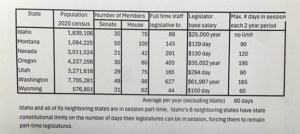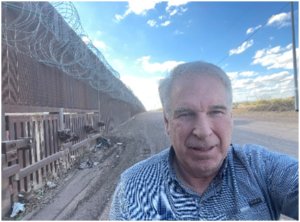Idaho’s Legislature
 thoughts for 2025, by State Senator Phil Hart
thoughts for 2025, by State Senator Phil Hart
January 25, 2025
ARTICLE II DISTRIBUTION OF POWERS
Section 1. Departments of government. The powers of the government of this state are divided into three distinct departments, the legislative, executive and judicial; and no person or collection of persons charged with the exercise of powers properly belonging to one of these departments shall exercise any powers properly belonging to either of the others…. Idaho Const. art. II (1890)
The Legislature of Idaho is not an equal branch of state government; it is the weakest of the three. The framers of the 1787 United States Constitution intended the legislative branch to be the strongest. We see this in Federalist Paper No. 51:
“In republican government, the legislative authority necessarily predominates.” Hamilton or Madison, The Federalist No. 51, (1788).
The legislative branch is the People’s branch of government. According to Federalist No. 51, government’s power is the “power surrendered by the people.” And we know from the Declaration of Independence that government gets its power from the consent of the governed. The sovereignty of our nation, and our state, resides in We the People. It would make sense that since the sovereignty of government resides in the People, that the Peoples’ branch of government should be the strongest.
The sovereignty we are talking about is actually given to us by God. What God has given, only God can take away. However, in Idaho, the Administrative State dominates state government.
“For the Lord is our judge, The Lord is our lawgiver, The Lord is our king; He will save us.” Isaiah 33:22.
Many believe Isaiah 33:22 was the inspiration for our form of government conceived by our founding fathers with power divided into legislative, executive and judicial branches. Using the terminology of Isaiah 33:22, the role of the king is to implement the law, and the role of the judge is to hold everyone accountable to the law. The role of the lawgiver is to make the law. This makes the law-giving branch of government the dominant of the three. In our system, the law-giving branch is the Peoples’ Branch of government.
The Idaho Constitution, ratified in 1890, is patterned after the United States Constitution. It intended for the legislative branch, as representatives of the people, to be the dominate branch. Back in 1890, the issues legislators needed to deal with were simpler and fewer. In 1890, the ‘common schools’ that the legislature is constitutionally mandated to provide for included only first grade through eighth grade and school was in session only three months in a year. Now it includes kindergarten through twelfth grade, junior colleges, four-year colleges, a nine-month school year, and we now argue if pre-kindergarten should also be included.
In 1890, when Idaho was founded, the legislature was considered part-time and met only every other year. The population of Idaho at that time was 88,548. Issues that Idaho’s Legislature must deal with include things that no one would have imagined decades ago like girls that want to be boys, boys that want to compete in girls’ sports, foreign drug cartels operating in our state, growth issues for a population that is expected to double in 25 years, and so on. Being a legislator in Idaho is now a full-time endeavor.
Legislator pay raise
In 2024, Idaho legislators earned $19,913 per year. There are insurance and retirement benefits that go along with the job similar to what any other large employer would provide for its employees. (Idaho legislators are classified as state employees.) There is also a per diem that out-of-town legislators get for living expenses during the legislative session in Boise. However, there are no paid holidays nor paid vacation. During the legislative session, we work through all the holidays; every week is a 5 day work week.
The way Idaho legislators cope with a full-time job with only part-time pay is to work on the immediate issues and rarely get to the less urgent. The bills one must pay to keep a roof over their head dictate that time must be spent on the legislator’s other day job. Though a bright line between what gets done, and what doesn’t get done doesn’t exist, history has shown that many issues get ignored.
A large proportion (75 percent) of the Arizona and Colorado respondents said they spend at least 70 percent of a full-time job on legislative work, and over two-thirds of Missouri and Oklahoma legislators made the same claim. None of these legislatures is considered full-time by the standard measures, supporting our argument that there is more time devoted to the job [as legislator than] by mere session length. Kurtz, Moncrief, Niemi, Powell, Full-Time, Part-Time, and Real Time: Explaining State Legislators’ Perceptions of Time on the Job, 322, 326, State Politics and Policy Quarterly, Vol. 6, No. 3 (Fall 2006).
In the same study quoted above, the authors received 2,982 completed questionnaires from state legislators, including 46 from Idaho. Across the 50 states, legislators reported that they spent 67% of a full-time job equivalent on their legislator activities, with Idaho legislators reporting their efforts constituted 59% of a full-time job.[2] Ibid. at 327.
The Idaho Constitution requires that the Governor give a State of the State address to the Legislature each year. It has become customary for the Chief Justice of the Supreme Court to also give an annual State of the Judiciary speech to the Legislature. But when was there ever a “State of the Legislature” speech given? Never, that I know of.
 In accounting, you often get better results when you monitor something. An item not monitored tends to be an item ignored. Today the “State of the Legislature” is rarely looked at in totality. This is reflected by the relative strength of the Idaho’s Legislature compared to the other two branches.
In accounting, you often get better results when you monitor something. An item not monitored tends to be an item ignored. Today the “State of the Legislature” is rarely looked at in totality. This is reflected by the relative strength of the Idaho’s Legislature compared to the other two branches.
As a percentage of the state budget, the legislative branch gets 0.15% or 1/662nd of the pie: $21,000,000 for the Legislature compared to $13,887,600,000 for all of state government.
In the entire history of Idaho, there has never been a judge impeached, yet the Legislature has the power to do so. Nor has there ever been a constitutional officer impeached in Idaho history. Yet the Legislature has the power to impeach. This is not because all judges and all constitutional officers are above reproach. An Idaho legislator is not equipped to take on such a huge task with such a puny salary and no administrative support staff to help in that effort. The impeachment power lies dormant because of a lack of resources.
When a bill gets signed into law that is unconstitutional, unless it is challenged by the citizenry in court, it gets ignored. In the last 20 years, the Health and Welfare budget has grown from $1.622 billion to $5.455 billion for a compounded growth rate of 6.3% , but there is not enough legislative oversight to try and get it under control. Legislators are bogged down with immediate demands and are unable to address the longer-term issues.
The mission of the Idaho Legislature is to preserve the checks and balances of state government by the independent exercise of legislative powers, to adopt a system of laws that promote the health, education, and well-being of Idaho’s citizens, to preserve the state’s environment and to ensure the wise [and] productive use of the state’s natural resources, to carry out oversight responsibilities to enhance government accountability, and to raise revenues and appropriate monies that support necessary government services, all in a manner so as to inspire public trust and confidence in elected government and the rule of law. Legislative Council, Strategic Plan, Legislative Services Office, November 10, 2005.
This mission statement above is excellent, but its implementation is not up to par. The disconnect occurs because there are not enough resources allocated to the legislative branch to carry out the mission. That the Administrative State dominates should not surprise anyone.
The position of legislator takes over 60% of my time and pays $19,913 (2024) per year. Given that I have bills to pay and must work in another profession creates a pile of unfinished business. Most Idahoans think their legislators get paid well over $100k a year and have an office staff of 2, 3 or 4 employees.
With no administrative staff for individual legislators,3Idaho Legislators exist in a state of perpetual embarrassment as we are unable to do the things that our constituents rightfully expect us to do. Constituents feel forgotten when our non-existent staff fails to reach out to them with either questions or solutions to their issues. This situation doesn’t serve anyone well.
Citizens Committee on Legislative Compensation
Last October, there was a proposal presented to the Citizens Committee on Legislative Compensation to increase legislative pay to $37k a year while taking away part of the legislative session’s per diem. The proposal was a non-partisan package put together by House and Senate leadership.
However, this leadership proposal got a lot of push-back, mostly from public policy lobbyists who see it as a fundraising opportunity. Ultimately the Citizens Committee on Legislative Compensation voted to give a $5,087 annual increase raising a legislator’s annual $19,913 salary to $25,000 a year.
The Citizens Committee for Legislative Compensation’s authority is found in the Idaho Constitution at Article III, Section 23. The people of Idaho authorized this authority to be added to our Constitution by approving it in the General Election of November 2, 1976.
The six-member committee is made up of 3 members appointed by the Supreme Court and 3 members appointed by the Governor. A review of the resumes of the current members reveals an impressive group with lots of real-world experience. The mechanism for a legislative pay raise is 100% within the domain of the Citizens Committee, who puts a pay raise in place by notifying the Idaho Controller of what the new salary is beginning on the first day of the new term, which occurs in December of even numbered years. The Controller then issues paychecks to legislators, as they do for all those who work for state government. The Citizen Committee’s report has the force and effect of law, as it doesn’t need anyone’s approval to be implemented.
Legislators don’t vote themselves a raise. However, by concurrent resolution, legislators may vote to give themselves a pay cut, but only if done so by the 25th legislative day of the new term. Legislator pay raises have been handled this way in Idaho since 1976. The next opportunity to adjust legislator’s salaries will come in November 2026.
‘“It’s all relative, of course,” Moncrief3said. “Legislators in low-population states where the legislature only meets a couple of months [a year] do not need to be paid six figures. But virtually all political scientists who’ve looked at this issue would agree, I think, that most legislators are underpaid for the work they do.” His co-author, Squire, suggested that at a minimum, legislative pay be pegged to the state’s median household income.
Malhotra said Americans’ suspicion of political institutions puts lawmakers in a bind. “It’s really irrational,” he said. “We don’t want to equip politicians with the resources to do their jobs, and then we blame them when things don’t work out the way we want.”’ Amelia Thomson-DeVeaux, How Much Should State Legislators Get Paid?, FiveThirtyEight, (Apr. 7, 2016).
Some critics think legislators shouldn’t get a pay raise unless there is a LGBTQ club in every high school and “no questions asked” taxpayer funded abortion on demand for everyone. Another group says legislators shouldn’t get a pay raise until state spending is deeply cut and the sales tax on groceries is eliminated. Idahoans wisely created the non-partisan Citizens Committee on Legislative Compensation to insulate the process from such political manipulation. Those dis-satisfied with the current process may want to run a constitutional amendment to eliminate the Citizens Committee on Legislative Compensation.
This Citizens Committee has been criticized for “pulling the $25,000 annual salary figure out of the sky.” Those who keep repeating this haven’t done their homework. The $25,000 per year figure was presented as 40% of the median individual Idaho state employee’s income by one of the Citizens Committee members at the 36 minute mark during their November 6th committee meeting. The committee’s use of that number has a rational basis.
Whereas the leadership proposal was said to be 40% of the average Idaho household income. Both proposals were attempting to provide a political justification which would peg a legislator’s salary to the people of Idaho.
A free market approach
There has been intense criticism of legislators who support a pay raise because “they knew a legislator’s pay was low when they ran for office.” Well, those same candidates also knew there was a Citizens Committee on Legislative Compensation in place to evaluate legislator’s salaries every two years. Those who support the pay raise also support the process put in place by the people of Idaho in 1976.
However, I would hope that in the aggregate, Idahoans would want highly qualified people serving them in the Legislature and would be willing to pay a salary appropriate to attract such candidates. This would be a free market approach.
A free-market approach to setting legislators’ pay would first delineate the requirement of the job, then assign to those requirements the qualifications necessary to perform the job, and finally look to the employment world to see what the pay rate is for that combination.
Idaho has 105 legislators who are responsible for setting a $14 billion dollar budget. That makes each legislator, on the average, a project manager a $133.3 million project. Legislators are a type of ‘Board of Directors’ for the state who establish policy, set the budget and to provide oversight for the entire state government, including its approximately 30,000 employees. This is a lofty assignment and needs above average people to do an effective job. What annual salary does the job market assign to this position?
If we looked at the issue the way a real estate appraiser values real properties, we could compare the current salaries of former legislators after they have moved on to other employment as compared to what legislators are paid today.
A former Representative from North Idaho recently resigned from the Legislature to take a job with Health and Welfare for $110,000 a year. Another former North Idaho Representative now makes $122,742 with the Idaho Public Utilities Commission. A former Senator is currently earning $162,240 a year as a director of an Idaho department. Another former House member now earns $111,376 working for an Idaho functional board. These salaries must be competitive in the free market, otherwise those former legislators mentioned above would work elsewhere.
The politics of fundraising
For some reason, giving Idaho legislators a $5,087 annual pay raise is a hill some are willing to “die on.” The entire pay raise package for 105 legislators will increase the state budget by 1/25,000th as a fraction of the entire budget. It represents an 8% per year increase if compounded over the last four years while the country has been suffering under Bidenomics. According to the Chapwood Index, a realistic measure of inflation, the Biden Administration has given us a 10% inflation rate on the cost of living since 2020. (See chapwoodindex.com)
Among a few conservative political action groups, the pushback against this pay raise has been brutal. With 1/25,000th of the state budget at stake, what would you expect? (The total amount in controversy for all 105 legislators is $534,000 on a budget of $14,000,000,000.)
These conservative groups call their methods “confrontational politics” where emotional arguments are made that anger the public. But only partial facts are presented, and mitigating facts that would fully inform the public are withheld. This deception is a form of lying. All the while, legislators are intimidated with a narrative of ‘we’ll break your legs politically if you disagree with us’. This is not an honorable process; it is mafia-style tactics. (However, it must be an effective method of fundraising.)
None of the conservative groups who oppose a legislator pay raise have a plan to diminish the dominance of the Administrative State. These conservative groups either favor a strong Administrative State and a weak legislative branch, or they are controlled opposition, or they are intellectually challenged and can only comprehend first order consequences.
Have Idaho legislators earned a pay raise?
Governor Little, in his 2025 State of the State address, said that He and the Legislature, have given $4.6 billion in tax relief in the last six years, which works out to about $800 per tax payer per year. In 2009 I ran HB218, a bill that exempted new houses and duplexes in Idaho from installing building code required indoor fire sprinkler systems saving Idahoans tens of millions of dollars, and that was just me. In 2007 I authored House Bill 82, a bill to eliminate the sales tax on food. Since then, there have been other bill introduced to eliminate the sales tax on groceries. Many Idaho legislators are constantly working to save Idahoans money. We could go on for pages.
I support the current pay raise proposal, as it is the best we are going to see this term. But in terms of strengthening our legislative branch of government, it has little impact. The Administrative State will still dominate.
Other States
One critic claimed that the proposed pay raise to $25,000 per year would cause Idaho legislators to be the highest paid part-time legislators in the country. This baseless claim has unfortunately been parroted several times.
The National Conference of State Legislatures (NCSL) does an excellent job collecting data on state legislatures. However, its analysis of that data is not so good. Legislatures should be divided into only 2 categories, full-time and part-time. (NCSL divides them into full-time, hybrid and part-time.)
A full-time legislature is a legislature that is in session year-round. There are ten of them. All other legislatures are part-time.
All of Idaho’s neighboring states have part-time legislatures
All of Idaho’s neighboring states have part-time legislatures. These six states have constitutional limits on the length of their legislative sessions. Yet, the complexity of the issues, and the sheer number of them make the legislator’s job full-time if he/she lives up to the expectations of the constituents.
The states that provide administrative staff assigned to individual legislators year-round free up the legislator to maintain their “citizen-legislator” status. Legislators from states (like Idaho) with no individual support staff find themselves in a full-time job with a part-time salary.

The way we can carve out the work assignments such that the legislator can be a so-called part-time “citizen legislator” is to support that person with administrative help. Eighty percent of states do just that.
To oppose this pay raise, in my opinion, shows a blindness to the greater problem, which is the dominance of the Administrative State. How do legislators push back against a dominate Administrative State with so little fuel in the fuel tank; with no ammo in the ammo box; and with worn out troops who scramble everyday to do a full-time job on part-time pay? Idaho legislators need more resources to fulfill their constitutional responsibilities. This pay-raise is needed. And if you doubled the raise, or tripled it, we would still have a dominant Administrative State. More work is needed before Idaho’s government becomes what the founding fathers intended it to be.
© 2025 Phil Hart – All Rights Reserved
E-Mail Phil Hart: northskiguy@yahoo.com
Footnotes:
1 Phil Hart is from North Idaho and served in the Idaho House of Representatives from 2004 until 2012. In 2022, Phil was elected to the Idaho Senate, where he serves today. Phil is a graduate of the University of Utah with a bachelor’s degree in Civil Engineering and of the University of Pennsylvania where he earned an MBA at The Wharton School of Business.
2 The survey took place in 2002. All 7,382 state legislators in the USA were sent the questionnaire. 2,982 legislators responded including 46 from Idaho. I (Phil Hart) served in the Idaho House of Representatives from 2004 to 2012. I can attest that being an Idaho legislator in 2025 is much more time consuming than it was in 2004.
3 Idaho is one of ten states where individual legislators have no year-round support staff.
4 Professor Gary Moncrief is a retired professor of Political Science from Boise State University. Professor Moncrief is a national expert nn state politics and state legislatures. Dr. Moncrief has written 6 books and published 55 articles regarding state legislatures.
 (Pictured here is Cochise County Arizona Sheriff Mark Dannels, center, with Senator Phil Hart, right, and Johnothan Alexander on the left of Live Border News, November 27, 2023, Sierra Vista Arizona. Cochise County and Santa Cruz County to its west see 25% of the fentanyl coming across it’s border with Mexico.)
(Pictured here is Cochise County Arizona Sheriff Mark Dannels, center, with Senator Phil Hart, right, and Johnothan Alexander on the left of Live Border News, November 27, 2023, Sierra Vista Arizona. Cochise County and Santa Cruz County to its west see 25% of the fentanyl coming across it’s border with Mexico.) Sen. Hart in Douglas Arizona (Cochise County) at the Mexico border November 26, 2023
Sen. Hart in Douglas Arizona (Cochise County) at the Mexico border November 26, 2023 Where I was on the border, Trump’s wall was obviously newly constructed. At the time of my 2013 visit, there was a shorter and more lightly constructed wall at this location, but the new Trump Wall is taller, stronger and more difficult to cross. Oh, that is where the wall was continuous. But there were also plenty of holes in the wall. I saw 6-foot-wide holes where a section of wall was missing. I also saw 75-foot-wide gaps in the wall at locations that get flash floods from desert monsoons.
Where I was on the border, Trump’s wall was obviously newly constructed. At the time of my 2013 visit, there was a shorter and more lightly constructed wall at this location, but the new Trump Wall is taller, stronger and more difficult to cross. Oh, that is where the wall was continuous. But there were also plenty of holes in the wall. I saw 6-foot-wide holes where a section of wall was missing. I also saw 75-foot-wide gaps in the wall at locations that get flash floods from desert monsoons. There is no excuse for any of these gaps in the wall. On my day job I work as a civil and structural engineer. I could design a wall that would secure our border yet allow for monsoon sized flash flooding to pass through the wall while keeping illegal aliens out.
There is no excuse for any of these gaps in the wall. On my day job I work as a civil and structural engineer. I could design a wall that would secure our border yet allow for monsoon sized flash flooding to pass through the wall while keeping illegal aliens out. The last group I saw were 64 illegal aliens from Guatemala, all women and children. These 64 women and children appeared out of nowhere just north of the 30-foot-tall structural steel border wall at our remote location. They were all dressed the same, they acted the same, they all seemed to be from the same economic and social class, and they saw our U.S. Border Patrol as their Disneyland E ticket provider. Just an hour earlier we had driven past this spot on the border, and no one was there. Then suddenly, in the middle of the night, 64 women and children appear, and only one of them spoke English.
The last group I saw were 64 illegal aliens from Guatemala, all women and children. These 64 women and children appeared out of nowhere just north of the 30-foot-tall structural steel border wall at our remote location. They were all dressed the same, they acted the same, they all seemed to be from the same economic and social class, and they saw our U.S. Border Patrol as their Disneyland E ticket provider. Just an hour earlier we had driven past this spot on the border, and no one was there. Then suddenly, in the middle of the night, 64 women and children appear, and only one of them spoke English. Worse yet, some of these border crossers will be trapped in sex slavery or will have their organs harvested. One member of our team on the border has witnessed a surge of children crossing the border immediately ahead of satanic holidays. Entering the United States with the aid of the cartels does not provide for a prosperous future for these people. This is a humanitarian crisis.
Worse yet, some of these border crossers will be trapped in sex slavery or will have their organs harvested. One member of our team on the border has witnessed a surge of children crossing the border immediately ahead of satanic holidays. Entering the United States with the aid of the cartels does not provide for a prosperous future for these people. This is a humanitarian crisis. Today (April 16, 2011) there are many issues that confront our political institutions. We are living in interesting times. For state governments the big issues are balancing budgets and federal government encroachment. And for the state of Idaho, the face of federal government encroachment is that of a Canadian Gray Wolf.
Today (April 16, 2011) there are many issues that confront our political institutions. We are living in interesting times. For state governments the big issues are balancing budgets and federal government encroachment. And for the state of Idaho, the face of federal government encroachment is that of a Canadian Gray Wolf. The Canadian Gray Wolf was introduced as a “nonessential experimental” species as defined by the Endangered Species Act. The ESA only allows the introduction of an “experimental species” when the original native species is extinct. But the Idaho Timberwolf was not extinct; we had about 80 of them. These Timberwolves were documented by recognized experts. No problem for the federal government, they just solved that dilemma by lying. Consequently, the introduction of the Canadian Gray Wolf into Idaho was based on fraud.
The Canadian Gray Wolf was introduced as a “nonessential experimental” species as defined by the Endangered Species Act. The ESA only allows the introduction of an “experimental species” when the original native species is extinct. But the Idaho Timberwolf was not extinct; we had about 80 of them. These Timberwolves were documented by recognized experts. No problem for the federal government, they just solved that dilemma by lying. Consequently, the introduction of the Canadian Gray Wolf into Idaho was based on fraud. When the states met in Philadelphia in 1787 to draft the Constitution, they met as individual sovereign states, each of whom possessed all the power of any sovereign government on planet Earth. In the process of drafting the Constitution, they delegated portions of their sovereignty to the federal government through the express language of the Constitution. And just to make it clear as to what the limits of that delegated power was, they included the Bill of Rights the Tenth Amendment of which states, “The powers not delegated to the United States by the Constitution, nor prohibited by it to the state, are reserved to the states respectively, or to the people.”
When the states met in Philadelphia in 1787 to draft the Constitution, they met as individual sovereign states, each of whom possessed all the power of any sovereign government on planet Earth. In the process of drafting the Constitution, they delegated portions of their sovereignty to the federal government through the express language of the Constitution. And just to make it clear as to what the limits of that delegated power was, they included the Bill of Rights the Tenth Amendment of which states, “The powers not delegated to the United States by the Constitution, nor prohibited by it to the state, are reserved to the states respectively, or to the people.” Anyone who might wish to challenge the exercise of Idaho’s police power used to protect Idahoans from the out of control number of Canadian Gray Wolves will have to exhaust their state administrative remedies before they go to court as required by section 3, paragraph 2 of HB343. In doing so, they will need to comply with Idaho’s Administrative Procedures Act and prove that (a) Canadian Gray Wolves are not a carrier of any disease that threatens humans, livestock or other big game animals, (b) there is no potential for human – wolf conflicts, nor (c) livestock – wolf conflicts, (d) the presence of Canadian Gray Wolves does not diminish property values (which would be a constitutional “taking” since these are governmentally introduced wolves) or (e) that the number of big game animals is not significantly impacted by the presence of the Canadian Gray Wolf.
Anyone who might wish to challenge the exercise of Idaho’s police power used to protect Idahoans from the out of control number of Canadian Gray Wolves will have to exhaust their state administrative remedies before they go to court as required by section 3, paragraph 2 of HB343. In doing so, they will need to comply with Idaho’s Administrative Procedures Act and prove that (a) Canadian Gray Wolves are not a carrier of any disease that threatens humans, livestock or other big game animals, (b) there is no potential for human – wolf conflicts, nor (c) livestock – wolf conflicts, (d) the presence of Canadian Gray Wolves does not diminish property values (which would be a constitutional “taking” since these are governmentally introduced wolves) or (e) that the number of big game animals is not significantly impacted by the presence of the Canadian Gray Wolf. By Phil Hart,
By Phil Hart, By Rep. Phil Hart
By Rep. Phil Hart